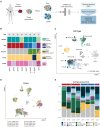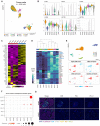Intertumoral lineage diversity and immunosuppressive transcriptional programs in well-differentiated gastroenteropancreatic neuroendocrine tumors
- PMID: 37756410
- PMCID: PMC10530100
- DOI: 10.1126/sciadv.add9668
Intertumoral lineage diversity and immunosuppressive transcriptional programs in well-differentiated gastroenteropancreatic neuroendocrine tumors
Abstract
Neuroendocrine tumors (NETs) are rare cancers that most often arise in the gastrointestinal tract and pancreas. The fundamental mechanisms driving gastroenteropancreatic (GEP)-NET growth remain incompletely elucidated; however, the heterogeneous clinical behavior of GEP-NETs suggests that both cellular lineage dynamics and tumor microenvironment influence tumor pathophysiology. Here, we investigated the single-cell transcriptomes of tumor and immune cells from patients with gastroenteropancreatic NETs. Malignant GEP-NET cells expressed genes and regulons associated with normal, gastrointestinal endocrine cell differentiation, and fate determination stages. Tumor and lymphoid compartments sparsely expressed immunosuppressive targets commonly investigated in clinical trials, such as the programmed cell death protein-1/programmed death ligand-1 axis. However, infiltrating myeloid cell types within both primary and metastatic GEP-NETs were enriched for genes encoding other immune checkpoints, including VSIR (VISTA), HAVCR2 (TIM3), LGALS9 (Gal-9), and SIGLEC10. Our findings highlight the transcriptomic heterogeneity that distinguishes the cellular landscapes of GEP-NET anatomic subtypes and reveal potential avenues for future precision medicine therapeutics.
Figures





References
-
- M. Pavel, K. Öberg, M. Falconi, E. P. Krenning, A. Sundin, A. Perren, A. Berruti; SMO Guidelines Committee. Electronic address: clinicalguidelines@esmo.org , Gastroenteropancreatic neuroendocrine neoplasms: ESMO Clinical Practice Guidelines for diagnosis, treatment and follow-up. Ann. Oncol. 31, 844–860 (2020). - PubMed
-
- J. Hallet, C. H. L. Law, M. Cukier, R. Saskin, N. Liu, S. Singh, Exploring the rising incidence of neuroendocrine tumors: A population-based analysis of epidemiology, metastatic presentation, and outcomes. Cancer 121, 589–597 (2015). - PubMed
-
- M. Cives, J. R. Strosberg, Gastroenteropancreatic neuroendocrine tumors. CA Cancer J. Clin. 68, 471–487 (2018). - PubMed
MeSH terms
Supplementary concepts
Grants and funding
LinkOut - more resources
Full Text Sources
Medical
Research Materials

